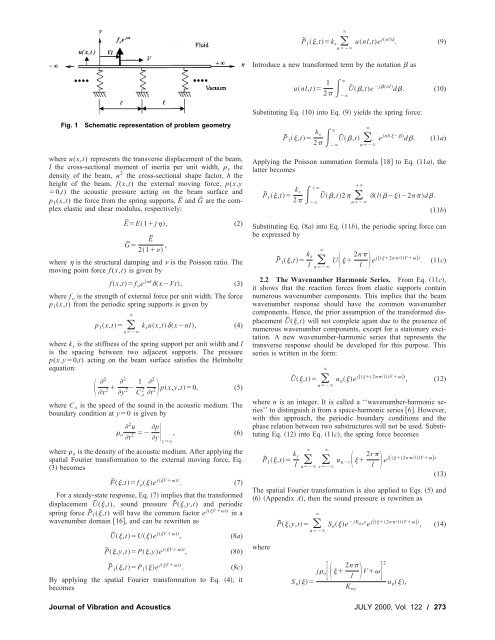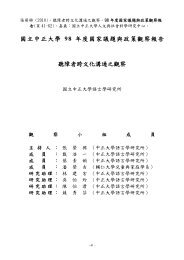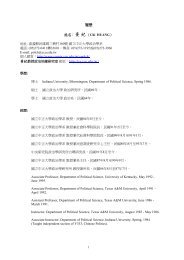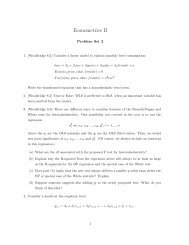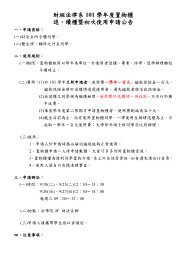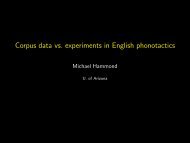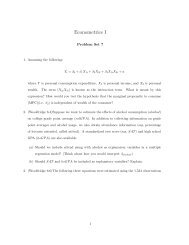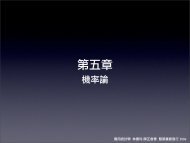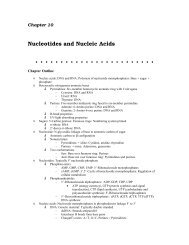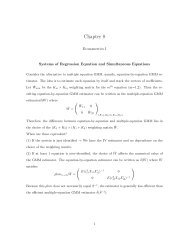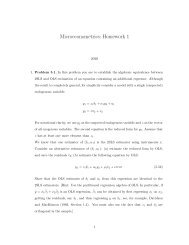Using ASME format
Using ASME format
Using ASME format
- No tags were found...
You also want an ePaper? Increase the reach of your titles
YUMPU automatically turns print PDFs into web optimized ePapers that Google loves.
P˜ 1,tk sn unl,te jnl . (9)Introduce a new transformed term by the notation asunl,t 12Ũ,te jnl d. (10)Substituting Eq. 10 into Eq. 9 yields the spring force:Fig. 1Schematic representation of problem geometryP˜ 1,t k s2Ũ,t ne jnl d.(11a)where u(x,t) represents the transverse displacement of the beam,I the cross-sectional moment of inertia per unit width, thedensity of the beam, 2 the cross-sectional shape factor, h theheight of the beam, f (x,t) the external moving force, p(x,y0,t) the acoustic pressure acting on the beam surface andp 1 (x,t) the force from the spring supports. Ē and Ḡ are the complexelastic and shear modulus, respectively:ĒE1 j, (2)ḠĒ21 ,where is the structural damping and is the Poisson ratio. Themoving point force f (x,t) is given byf x,t f o e jt xVt, (3)where f o is the strength of external force per unit width. The forcep 1 (x,t) from the periodic spring supports is given byp 1 x,tn k s ux,txnl, (4)where k s is the stiffness of the spring support per unit width and lis the spacing between two adjacent supports. The pressurep(x,y0,t) acting on the beam surface satisfies the Helmholtzequation: 2x 2 2y 2 1 C o2 2 2px,y,t0, (5)twhere C o is the speed of the sound in the acoustic medium. Theboundary condition at y0 is given by 2 u ot 2 p, (6)yyowhere o is the density of the acoustic medium. After applying thespatial Fourier trans<strong>format</strong>ion to the external moving force, Eq.3 becomesF˜ ,t f o e jVt . (7)For a steady-state response, Eq. 7 implies that the transformeddisplacement Ũ(,t), sound pressure P˜ (,y,t) and periodicspring force P˜ 1(,t) will have the common factor e j(V)t in awavenumber domain 16, and can be rewritten asŨ,tUe jVt ,P˜ ,y,tP,ye jVt ,(8a)(8b)P˜ 1,tP 1 e jVt .(8c)By applying the spatial Fourier trans<strong>format</strong>ion to Eq. 4, itbecomesApplying the Poisson summation formula 18 to Eq. 11a, thelatter becomesP˜ 1,t k s2Ũ,t2n l2nd.(11b)Substituting Eq. 8a into Eq. 11b, the periodic spring force canbe expressed byP˜ 1,t k slnU 2nl e j2n/lVt . (11c)2.2 The Wavenumber Harmonic Series. From Eq. 11c,it shows that the reaction forces from elastic supports containnumerous wavenumber components. This implies that the beamwavenumber response should have the common wavenumbercomponents. Hence, the prior assumption of the transformed displacementŨ(,t) will not complete again due to the presence ofnumerous wavenumber components, except for a stationary excitation.A new wavenumber-harmonic series that represents thetransverse response should be developed for this purpose. Thisseries is written in the form:Ũ,tn u n e j2n/lVt , (12)where n is an integer. It is called a ‘‘wavenumber-harmonic series’’to distinguish it from a space-harmonic series 6. However,with this approach, the periodic boundary conditions and thephase relation between two substructures will not be used. SubstitutingEq. 12 into Eq. 11c, the spring force becomesP˜ 1,t k sln urnr 2rl e j2n/lVt (13)The spatial Fourier trans<strong>format</strong>ion is also applied to Eqs. 5 and6 Appendix A, then the sound pressure is rewritten aswhereP˜ ,y,tn S n e jK ny y e j2n/lVt , (14)S n j o 2n 2l VK nyu n ,Journal of Vibration and Acoustics JULY 2000, Vol. 122 Õ 273


